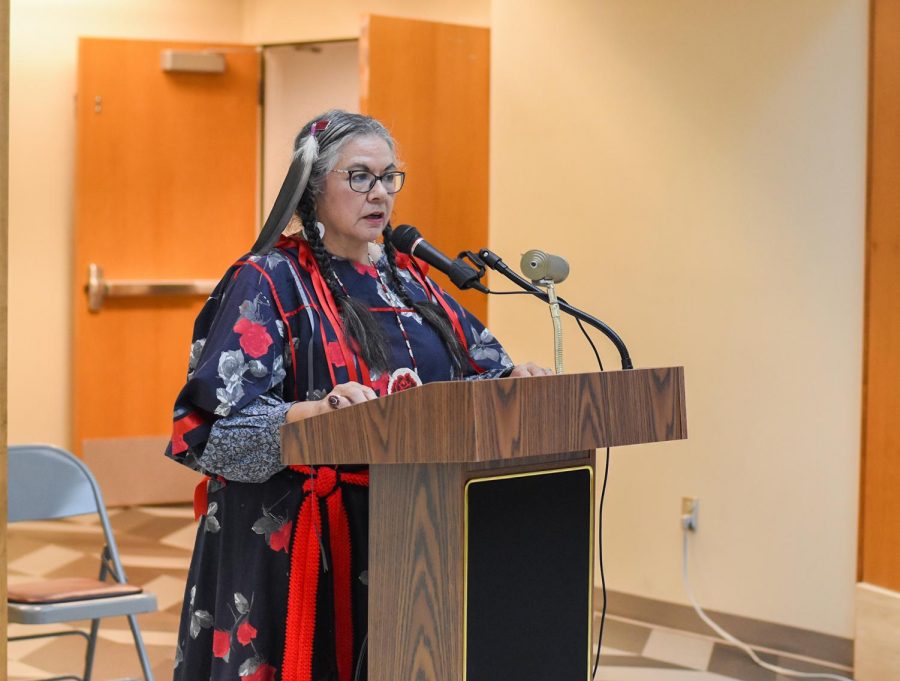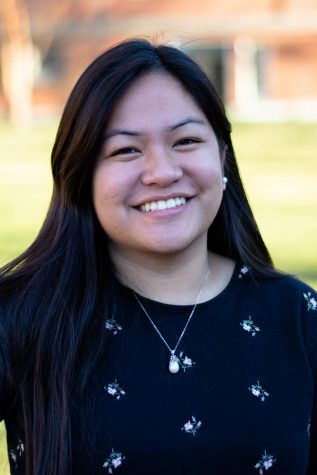‘If we don’t tell the story, the truth will not be heard’
Native American boarding school exhibit to be shown
Roberta Paul speaks at Terrell Library about her family’s experience in boarding schools and her grandfather’s trunk, which held many items with cultural significance.
October 28, 2019
At some point, a wooden crate that housed an upright piano became the ideal hiding spot for Jesse and Lydia Paul’s young daughters.
“Grandfather Jesse and grandmother Lydia did not want their young children taken away to boarding school,” said Roberta Paul, Nez Perce Tribe member.
Roberta said the crate prevented an Indian agent from taking away her grandparent’s daughters at that time, but eventually, they had to attend Chemawa Indian School when they were teenagers.
The wooden crate is just one of the things situated on the bottom floor of Terrell Library. WSU’s Manuscripts, Archives and Special Collections (MASC) will have an exhibit up until mid-March that showcases the experiences of some of Roberta’s family members at Native American boarding schools.
Roberta said this was the second time she showcased her items to the public. MASC has more of her family’s personal items on display compared to the first time she curated her exhibit.
“If we don’t tell the story,” she said, “the truth will not be heard.”
Roberta said Jesse’s trunk made her question a lot of things about her family history that were left unanswered for a while.
“As a young child, I would go through the trunk and fondle things and say, ‘What is this,’ ‘What does this mean,’ ‘What are those photos of my ancestors,’ and I didn’t know who they were because my father didn’t talk about it very much because they were gone,” she said.
Jesse obtained the trunk after he attended the Carlisle Indian boarding school, Roberta said. Children at the school were taught English, math and reading. They were also required to learn a specific skill, and Jesse was assigned to learn wagon-making.
She said after Lydia’s death, Jesse gathered some of Lydia’s belongings, packed them in his trunk and sent it to Titus, Roberta’s father.
“These items are my connection to the lives of my ancestors and their stories,” Roberta said.
The boarding school Jesse attended was established by Brigadier Gen. Richard Pratt, she said, who thought that immersing Native Americans in the “white man’s culture” could help them survive in the new world.
“[It was] the stripping away of cutting their hair and taking them out of buckskin, putting them in uniforms, and making them not speak their language,” Roberta said.
Tsitsistas tribe member Marsha Small said exhibits like this shine a light on the “atrocities” that occurred in the past.
“We’re bringing the indigenous narrative into this,” Small said.
She said she has been doing research on Indian boarding school cemeteries for 7 years. One of the most difficult things she faced was realizing that children as young as 2 years old were buried at that time.
Roberta said having the exhibit speaks the truth and promotes representation.
“We are still struggling, and we have to fight with all of our being to still be here,” she said. “We are still here.”











Tod Merley • Nov 4, 2019 at 9:28 pm
I remember watching “Westerns” as a child which were produced in the fifties (I am now 65). Playing “Cowboys and Indians” was even a thing back then.
But recently Pullman Parks and Recreation has provided me trips to various Casinos in Washington and Idaho. Indeed I will be at the Northern Quest Casino with many others with the Senior Center Tuesday.
They all have an area you might think of as a “mini museum” where the history and culture of the tribe which manages the casino is shown. That got me looking into many books about the history which actually occurred as we simply took their land and mostly wiped them out.
Simply I am deeply ashamed. I am deeply regretful. I hope we find a way to give them their lifestyles back. I hope we learn to mind our own business and to be a help rather than a horror to those we come in contact with.
Roberta C Capasso • Nov 4, 2019 at 1:15 pm
Yes, it is so important that our stories be told so the truth comes out. I am 66 years old and just learning about my Oneida background. I learned about how my Great Grandmother, Sophia Huff and her sister, Lily Huff, were forced to attend the Carlisle Indian Industrial Boarding School to be assimilated into the Euro-white culture. Their names were changed to English names. They were forbidden to speak any language except English. I spent fifteen years researching why Sophia and Lily had to attend Carlisle. The government felt these girls needed to be Christianize d and saved. I self published a book called: Sky Woman Lives in Me about my relatives, me, our government and Carlisle’s assimilation experiment. It hurt at times to find out the true story from relatives and research. But, I feel that if one indigenous person shares their story as a result of me sharing mine, great! May Our Creator, God, Bless us all.
francine R michaels • Nov 2, 2019 at 6:06 pm
HONEY I NEVER KNEW THERE WERE SO MANY TRIBES!! WHEN I STARTED READING WHAT WENT ON I CRIED FOR EVERYONE!! MY HEART STILL ACHES. GREED CAUSED ALL THE PROBLEMS FOR THE AMERICAN NATIVES!! THE GOVERNMENT CAN NOT KEEP WALKING OVER THE AMERICAN NATIVES!! THEY MUST GET THE PROPERTY THEIR lOVED ONES ARE BURIED IN. THERE ARE LAWS IN OUR COURTS ABOUT DAMAGING GRAVES. OPEN THE BOOKS AND LAY THAT LAW DOWN!! I DO NOT CARE IF GETTING It STRAIGHT COSTS MONEY, YOU CAN NOT PUT A DOLLAR ON A loved ones life!!!
Theresa White Mountain • Oct 30, 2019 at 10:50 am
It’s hard to share my BOARDING SCHOOL night-mares. Taken from my parents at the age 7 and put in the 1st BOARDING SCHOOL at Pine Ridge,S.D. is memories that I thought would not matter to another. I never understood why I went to sleep one night only to be taken in the night to a dorm full of other girls. Crying, looking out the Windows for FAMILY. Locked in wishing for my parents. All for the White man’s education. The mental, emotional, physical abuse that went on for their GOD and EDUCATION. I have to stop now. It’s so hard and tears won’t stop. Maybe another time.